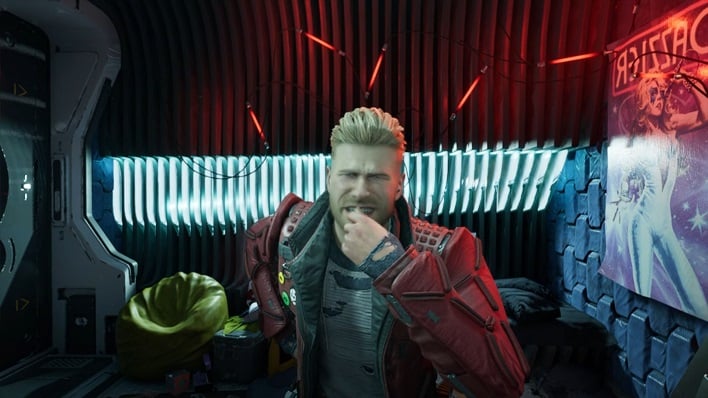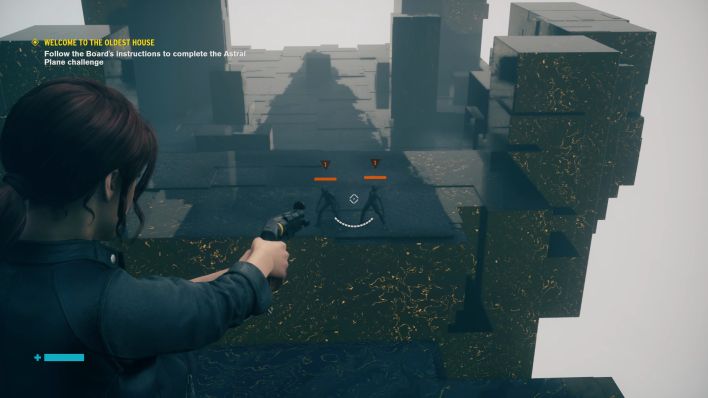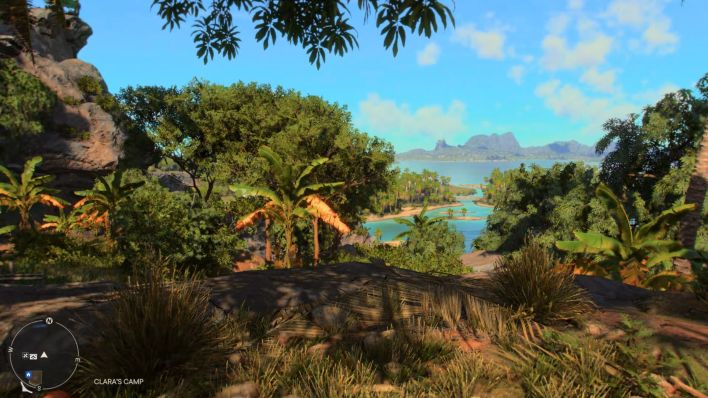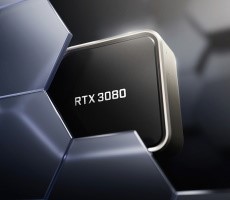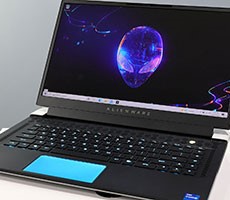NVIDIA GeForce NOW RTX 3080 Review: Your Killer Gaming Rig In The Cloud
GeForce NOW RTX 3080: Impressive Cloud-Driven PC Gaming Performance And Low Latency
We got to take the newest version of GeForce NOW for an early spin and chose to do so on a couple of systems that seem to be meant for the service. Neither machine is a real gaming rig: one, a 2020 Mac mini with Apple's M1 processor, and a desktop with a Ryzen 7 5800G featuring AMD's integrated Vega graphics. Game streaming services like GeForce NOW can really enhance the functionality of these PCs, assuming it works as billed. So, let's find out...
Taking GeForce NOW RTX 3080 For a Spin
GeForce NOW veterans are probably familiar with the service, but let's take a moment for the uninitiated. NVIDIA's game streaming service is effectively a low-latency remote session running on a virtual gaming rig hosted on a GeForce NOW SuperPOD in one of the company's datacenters. The games that are available to play come from users' own game libraries, spanning multiple services including Steam, Epic, GOG, and more.GeForce NOW has a selection of free-to-play games as well, but the focus is on games that players already own. The idea is that you can play those games from almost anywhere on virtually any device without the need for expensive discrete graphics cards or high-end CPUs, since all of the heavy lifting takes place in the cloud.
To gain access to a game, you simply have to own it on one of the supported platforms. When a game is available on multiple storefronts, the app lets you choose which service to log into. The first time you launch a game on a given service, you'll need to provide your own account details; if you don't own the game, you can't play it unless it's a free-to-play title.
Not every game on each service is available for play. However, there's a pretty sizable chunk of our own library available, including the high-profile, day one release Marvel's Guardian of the Galaxy from Square-Enix. This is a major coup for NVIDIA, since the games are what make the service. While gamers still need to buy the game in order to play it, GotG's presence on GeForce NOW means that they don't also have to fight the hordes for an in-demand graphics card if they don't already have one.
NVIDIA says it's working with publishers to get more experiences like this for its subscribers. It's also worth noting that when Far Cry 6 shipped, it was available on GeForce NOW at launch. Plenty of other popular AAA titles are available too, including hits like Battlefield 1, Control, and MechWarrior 5.
The latest entry, the GeForce NOW RTX 3080 tier, extends sessions to 8 hours, but more importantly eliminates some of the previous performance limits. The maximum supported resolution and frame rate on PC and Mac with the RTX 3080 tier is 2,560 x 1,440 at 120 Hz, while the NVIDIA SHIELD with an HDMI 2.0b connection can play at up to 4K and 120 Hz, with HDR. There are some bandwidth and latency requirements that come along with this, which we will get to shortly.
GeForce NOW RTX 3080 Latency
Speaking of latency, NVIDIA's own internal lag measurements say that GeForce NOW has less "click-to-draw" latency than the integrated graphics found in many typical laptops. In Destiny 2, for example, NVIDIA says that GeForce NOW RTX 3080 has a total of 56 milliseconds of click-to-draw latency, vs. over 200 milliseconds for a laptop with Intel's UHD graphics. NVIDIA provided its own chart, measured with LDAT, below.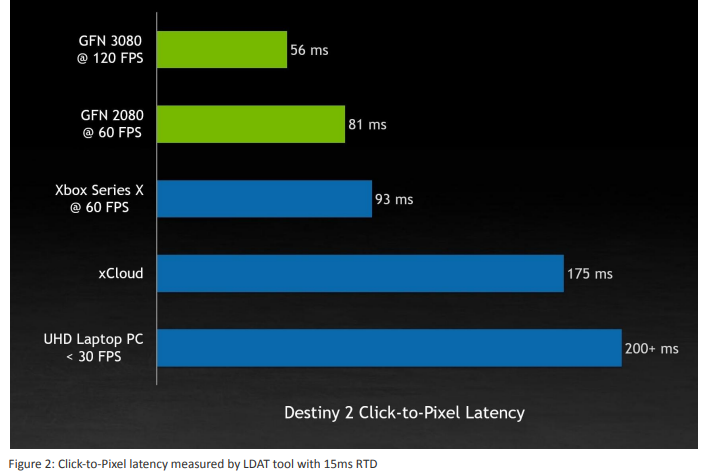
This chart shows just one game -- Destiny 2 -- but if it holds up, we expect the general trend to be about the same even if the absolute numbers don't match up across the board in every game. To our eyes and hands, which are used to high-end gear and fast response times, the games with played on GeForce NOW still felt very good. It's not quite as responsive as native rendering directly on the client machine, but it's still quite playable. Without being able to measure with the same accuracy for ourselves, we don't think most gamers will notice. Combat in Cyberpunk 2077 and Battlefield 1 was quite responsive. Slower-paced games like Battletech were indistinguishable from a regular gaming PC.
To reduce latency further, NVIDIA has multiple presets as well as custom settings in the GeForce NOW application. The Competitive preset should lower latency to its lowest possible results. To achieve that, the resolution does get dialed back to 1080p with a 120 Hz refresh rate, though. Monitors with adaptive sync -- either FreeSync or G-Sync -- will have the best experience with the Competitive preset. Of course, the latency will vary based on your internet connection. All of the other latency figures above will be affected negatively if your connection to the game streaming servers isn't responsive.
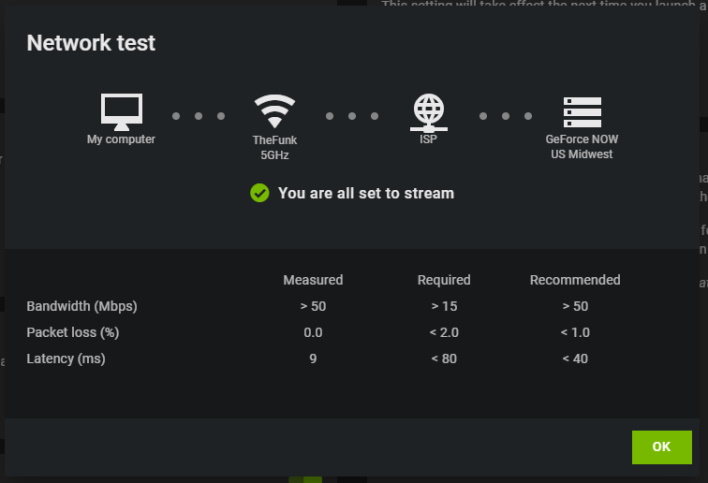
A low-latency internet connection is just one key aspect of GeForce NOW, though. There also needs to be sufficient bandwidth. GeForce NOW requires a minimum of 15 Mbps down and a maximum of 80 milliseconds of latency. Higher video quality settings require higher throughput, however, and that can stretch upwards of 40 Mbps for 1440p at 120 Hz.
To help with optimizing the video quality for your connection, GeForce NOW has several presets and a configurator. Data Saver will likely be handy for Comcast and other users that are subject to data caps. My 400/100 internet connection is really a best-case scenario for GeForce NOW, but some folks are at the mercy of their ISPs and may want to tailor things accordingly.
Playing Games On GeForce NOW RTX 3080
All this talk of latency and bandwidth is meaningless unless the games look good and run well. So, of course, we had to spend a few days with the service playing our favorite games across Steam, GOG, and Ubisoft Connect. In every title we tested, the experience was great. We generally stuck to the most strenuous options of 1440p, 120 Hz, and an automatic bitrate. We also stuck to Wi-Fi even though wired Gigabit Ethernet would probably be faster, just to give GeForce NOW a bit of a challenge and use a configuration representative of most consumers. It's not slow Wi-Fi by any means, however; our test systems both have 802.11ax Wi-Fi 6 modules and our ASUS AX3000 router is pretty high up on the food chain.The proof is in the screenshots, we think, so you'll see some images scattered throughout the rest of the article showing off what games look like running on GeForce NOW RTX 3080.
We also took some time to do some performance testing. Since GeForce NOW isn't running the games locally, the manual testing we've previously done in games like Cyberpunk 2077 and Control is impossible since CapFrameX doesn't get PerfMon data. However, some of the games we played have built-in benchmarks and we can show those results.
First of all, playing on a regular PC and moving to GeForce NOW has one drawback: if the service you're playing a game on does not support cloud saves, there's no way to pick up where you left off. Fortunately, Steam, GOG, and Ubisoft all support cloud saves, so there was no loss of game save data in our particular experience. The Epic store, however, didn't seem to work that way for us, and when we started Control we had to start the game over entirely. That's a bit of a disappointment, but not the end of the world unless you've got a lot of progress to bring over. It'd be nice to get a way to transfer save data from our PC to GeForce NOW, if possible. (Note: NVIDIA tells us that shouldn't have happened, so we're working to figure out why it did)
The other downer is that we have to log into each service to verify we own the games, and that's fine if you know your password. Unfortunately for me, I use Bitwarden and randomly generate all my passwords. That means to log into each store is a matter of meticulously typing randomized 20-character codes. GeForce NOW does link to Steam and Epic accounts to scrape what games are available, but we still had to log into both storefronts. Fortunately you only have to do that once, or it'd be a real pain.
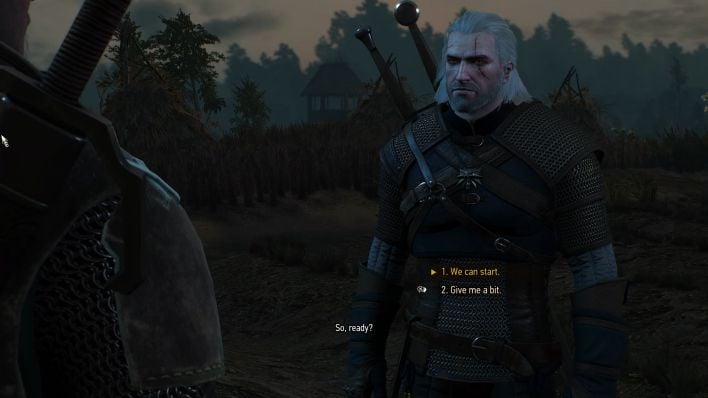
Fortunately, the games almost universally looked great. You could occasionally wind up with some compression artifacts on lower bitrate settings, and that could really tear down the immersion. However, when we put our full internet connection to the test -- or at least, as much as GeForce NOW would use -- everything was quite smooth and beautiful. We didn't really see video blurring or quality drops when the service was in control of the bitrate. However, there was one exception.
For whatever reason, Far Cry 6 was pretty challenging for the video encoder. The foliage and diverse color palette are most likely the culprits, as the image has a very high contrast between the leaves of green and the shadows of nigh-on black everywhere. In motion it wasn't extremely obvious, but when we stopped to look around, we could see small halos around the edges of trees. That all went away when we cranked the bitrate up to 50 mbps, however, which is the maximum supported by the updated GeForce NOW application.
GeForce NOW RTX 3080 Cloud Gaming Performance Benchmarks
Overall, playing games felt fluid and responsive. Because 120 Hz is available to GeForce NOW RTX 3080 subscribers, we had to wonder how much performance is actually on tap. Surely we didn't get to witness the firepower of a fully operational GeForce RTX 3080 in the cloud, did we? Games that have built-in benchmarks could help us out, so we ran a few tests.For each game, we benchmarked at 1080p and 1440p, but we left the settings alone. NVIDIA optimizes each game available on the service using an algorithm similar to the GeForce Experience app. We took those default settings, which targeted medium-to-high hand-tuned configurations, and ran the built-in benchmarks. For our tests, we selected Far Cry 6, Shadow of the Tomb Raider, and Watch Dogs: Legion.
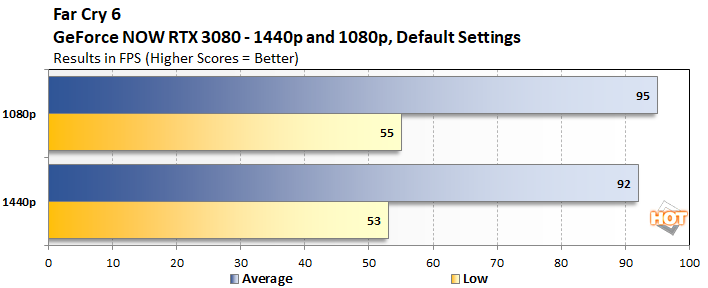
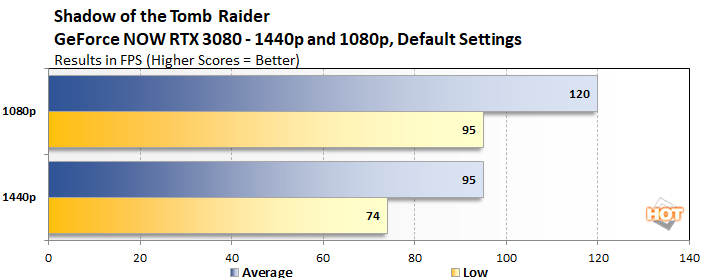

Generally speaking, it looks like GeForce NOW RTX 3080 is targeting an average frame rate of around 85-95 fps for 1440p gaming, and then whatever else it can get at 1080p. The exception to that is FarCry 6, which is notoriously CPU-bound. Dropping the resolution did relatively little. We could see in-game that the GeForce NOW servers run on AMD Threadripper Pro 3000-series CPUs, which use the Zen 2 architecture like the PlayStation 5 and Xbox Series consoles.
With a name like RTX 3080, we did wonder, though: how fast is GeForce NOW RTX 3080 compared to a typical gaming PC? Unfortunately I didn't have a physical GeForce RTX 3080 handy, so we took our test rig, which has a Ryzen 7 5700G, 32 GB of DDR4-3200 RAM, and a GeForce RTX 3070 for a spin in Guardians of the Galaxy and compared it to the in-game bench running on GeForce NOW RTX 3080. The game supports ray-traced reflections and transparency effects, although the shadows rely on shadow maps rather than fancy DXR effects. There's also support for DLSS 2.0, but we didn't really need it on either platform.
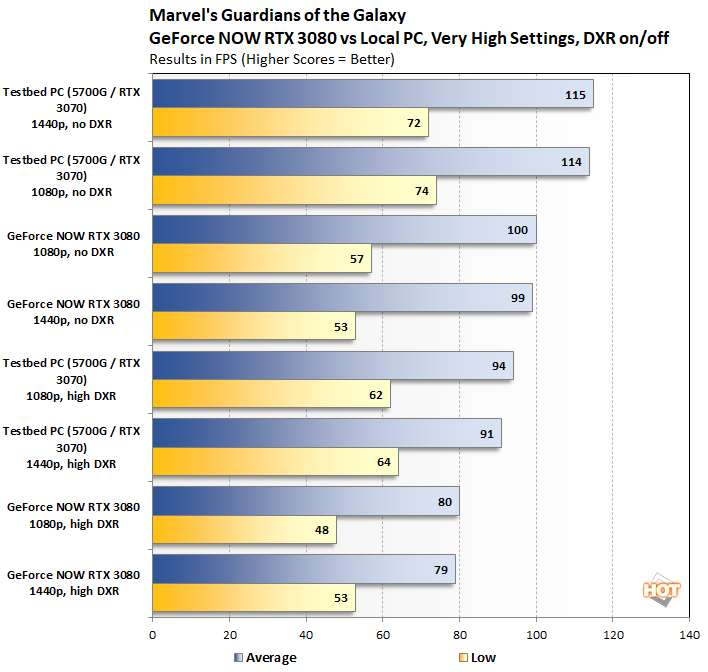
GotG seems like it's pretty CPU-limited, since on both GeForce NOW and our local PC, the performance difference between 1080p and 1440p is pretty minimal. As a result, we don't really get a clear picture of just how much graphics horsepower GeForce NOW RTX 3080 has on tap, but games identify the host as having an NVIDIA A10 Tensor Core GPU, which is quite a beast. The older Zen 2 architecture of the Threadripper Pro and the particular VM configurations on NVIDIA's servers might be limiting things somewhat. Regardless, it doesn't really matter, because we still averaged well over 70 fps without any DLSS and the highest possible settings. It's extremely fast, and playing on a PC-esque platform rather than a console means we can tune the experience to our hearts' content.
GeForce NOW RTX 3080 Experience Take-Aways And Conclusions
GeForce NOW RTX 3080 is a pretty sweet way to play games in a world where physical graphics cards are a highly sought-after commodity with unreasonable market dynamics currently. However, at some point, we expected any cloud gaming service to impart a latency penalty that would feel laggy and unresponsive, but that was not part of our experience. Assuming there's plenty of bandwidth and a low-latency internet connection available, GeForce NOW felt almost as responsive as a local, high-end gaming PC. That said, it's probably not going to be as handy on the road where hotel Wi-Fi is spotty, or in cellular hotspots that can incur notoriously high latency in some areas. Regardless, with macOS compatibility on the latest Apple Silicon devices, GFN RTX 3080 even turns a lowly Mac mini into a PC gaming powerhouse, and the operative word is "PC" here.The wild card is pricing. At $99 for a six-month subscription, GeForce NOW RTX 3080 costs $16.50 a month, a little less than Netflix. The thing is, Netflix doesn't have additional costs on top of the subscription; it's not like you have to buy Die Hard before streaming it, whereas with GeForce NOW you do have to spring for the games themselves, if you don't already own them. However, the service would likely cost far more if the games themselves were included, especially considering hot, day-one releases like Far Cry 6 and Guardians of the Galaxy. And the beauty of NVIDIA's GeForce NOW service in general is that a lot of the titles that are already in your game library can now be played on a lot more devices than just a powerful gaming PC.
The bottom line good news is NVIDIA's GeForce NOW experience is solid. If you've been trying to upgrade to a recent graphics card but have been frustrated at availability or pricing, or have no interest in trying to keep up with the latest technology at home, GeForce NOW RTX 3080 is a great way to weather the current shortages, with the added benefit of being able to play on a wide range of devices and platforms.


